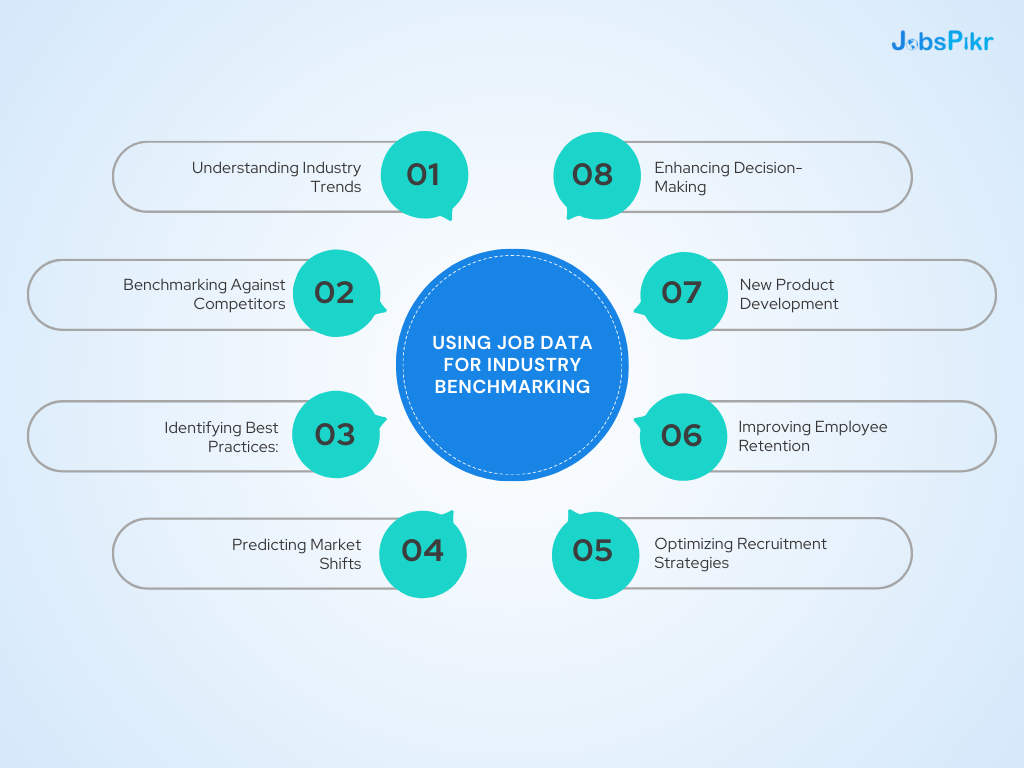In the world of business, knowledge is power. Data empowers organizations to understand customer behavior, take risks, and achieve success. Today, it’s hard to think that there was a time when decisions were taken without any data. But is that all there is to do with data-driven insights? At the end of the day, how do you even measure yourself to see how you are faring in the bigger picture? This is where industry benchmarking comes in.
What is Industry Benchmarking?
It’s a way for businesses to measure their performance against others in the same industry. You’re not just looking at your own progress; you’re comparing it to everyone else’s to see where you stand. By benchmarking against other enterprises, you can identify areas where you excel and areas where you need to step up your game. So basically, it’s like a reality check.
Let’s say you own a coffee shop. You want to know if your sales are brewing success or if you’re just spilling beans. By comparing your performance with other coffee shops in your area or state, you can see if you’re doing fine or if it’s time to switch up your strategy.
But it’s more than just sales numbers. Many other aspects need to be compared to see how your coffee shop is performing. Are your costs higher? Are your customer satisfaction scores lower? With industry benchmarking, you spot areas of improvement and set new goals. You keep a tab on how your rivals are doing, too. It’s like comparing notes to see who’s doing the best and who could use a little boost.
Additionally, industry benchmarking helps businesses set realistic goals for performance improvement. By understanding what is achievable within their industry and competitive landscape, companies can set targets that are not just ambitious but also attainable. This is crucial for driving motivation and focus among employees.
Using Job Data For Industry Benchmarking
Now that we’re clear about the core concept, let’s look at how you can leverage job data for industry benchmarking. How exactly does job data empower enterprises to gain a competitive advantage? Let’s explore this with some examples of its transformative power.

1. Understanding Industry Trends:
First and foremost, job data provides a bird’s-eye view of hiring trends across various industries and geographic regions. By analyzing job postings, companies can gain insights into emerging skill requirements, in-demand roles, and evolving labor market dynamics.
For instance, a technology company can use job data to track the rising demand for AI specialists or cybersecurity experts. This information allows them to anticipate future talent needs and adjust their hiring strategies accordingly.
2. Benchmarking Against Competitors:
Job data enables businesses to conduct a comparative analysis of various recruitment metrics. For instance, metrics like job volume, time-to-fill, candidate quality, hiring costs, etc. By comparing these metrics with industry benchmarks or competitors’ performance, companies can clearly understand how they stack up against their peers.
For instance, let’s say a company wants to benchmark its recruitment efforts against competitors in the same industry. They can evaluate aspects like hiring speed, efficiency, and diversity, enabling them to optimize their talent acquisition strategies and gain a competitive edge in the market. Tools like JobsPikr that offer comprehensive job data are very valuable in such situations where you need to assess relative performance.
3. Identifying Best Practices:
Industry benchmarking enables businesses to identify and adopt best practices from industry leaders and top performers. By studying how competitors achieve success in areas such as marketing, operations, and customer service, companies can implement better strategies to enhance their own performance.
For example, let’s say a retailer is analyzing job postings from leading retailers in their industry. By examining the language, job requirements, and responsibilities listed in these postings, the retailer gains insights into the skills and qualities that successful retailers prioritize in their hiring process. Based on this, the retailer can revamp their job postings to emphasize the skills they are looking for and offer perks that level up to their competitors.
4. Predicting Market Shifts:
In addition to identifying current trends, job data is a powerful predictive tool for anticipating shifts in the labor market. Enterprises can analyze hiring patterns and job trends to forecast future talent shortages or skill gaps. This predictive insight enables them to proactively adjust their workforce planning strategies and capitalize on emerging opportunities.
For instance, consider a scenario where job data from the healthcare sector forecasts a growing demand for telemedicine professionals or healthcare data analysts. This information helps healthcare organizations create/invest in training programs or strategic partnerships to make sure their future workforce needs are duly met.
5. Optimizing Recruitment Strategies:
In today’s competitive job market, attracting top talent is essential for business success. By leveraging job data, enterprises can gain insights into candidate preferences, salary trends, and employer branding strategies. This helps them optimize their recruitment strategies to improve their employee onboarding experience.
For instance, if a company discovers that its competitor is able to fill similar positions in half the time, it may reconsider its sourcing channels, revise job descriptions, or streamline its interview process to expedite hiring and stay competitive. It can use job data to identify competitive salary benchmarks and enhance its employer brand image to attract top talent.
6. Improving Employee Retention:
Job data can also help companies identify factors that contribute to employee turnover and retention. Job data insights and employee movements within their industry help businesses identify trends related to job satisfaction, career advancement opportunities, and competitive compensation.
With this information, companies can implement initiatives to boost employee engagement and enhance workplace culture to reduce turnover rates. They can also introduce policies that improve employee experience to ultimately strengthen their competitive position in the market.
7. New Product Development:
This is one of the coolest benefits of leveraging job data for industry benchmarking. As mentioned above, job data provides insights into industry trends, emerging skills, and evolving job roles. This can inform enterprises about market affinity towards new products and help give the right direction to development efforts.
By understanding the change in demand, companies can develop related products and services that align with market needs and capitalize on emerging opportunities. For example, a software company can use job data to create new products as an add-on to their existing products. This helps them meet market demand and expand their revenue stream.
8. Enhancing Decision-Making:
Ultimately, job data empowers businesses to make informed decisions based on data-driven insights rather than intuition or guesswork. Be it entering new markets, reallocating resources, or capitalizing on emerging opportunities — benchmarking with the help of job data ensures that decisions are based on a thorough understanding of industry dynamics and competitive positioning.
This also has the added benefit of enhancing stakeholder confidence since it demonstrates that a business is committed to excellence and continuous improvement. Whether it’s investors, customers, or employees, benchmarking assures that a company is dedicated to delivering value and achieving its goals.
Sophisticated tools like JobsPikr that give structured job data and real-time updates can unlock a world of opportunities for businesses to benchmark their performance, anticipate market trends, and optimize their talent acquisition strategies. So why wait? Harness the power of job data with JobsPikr and take your business to new heights of success!



